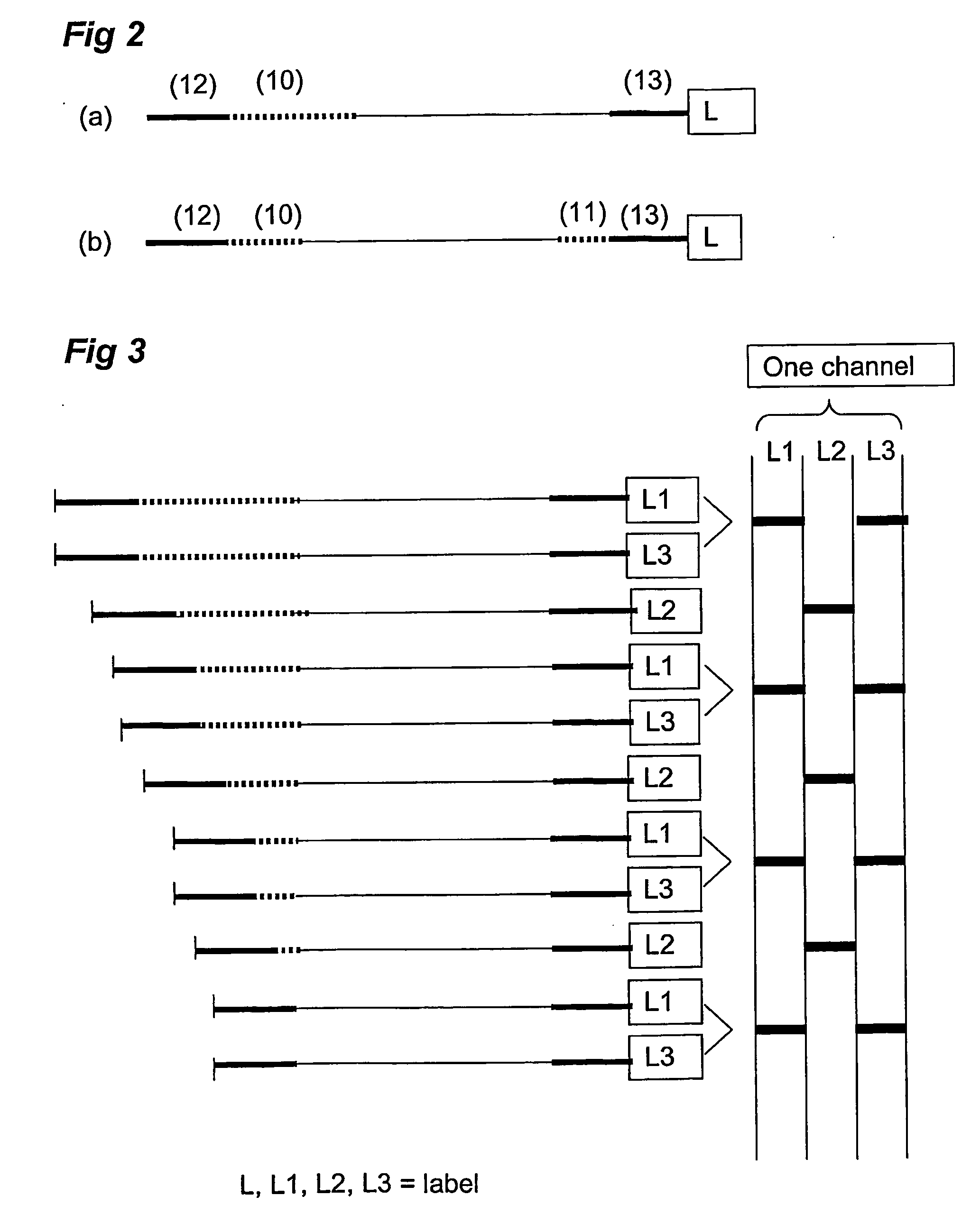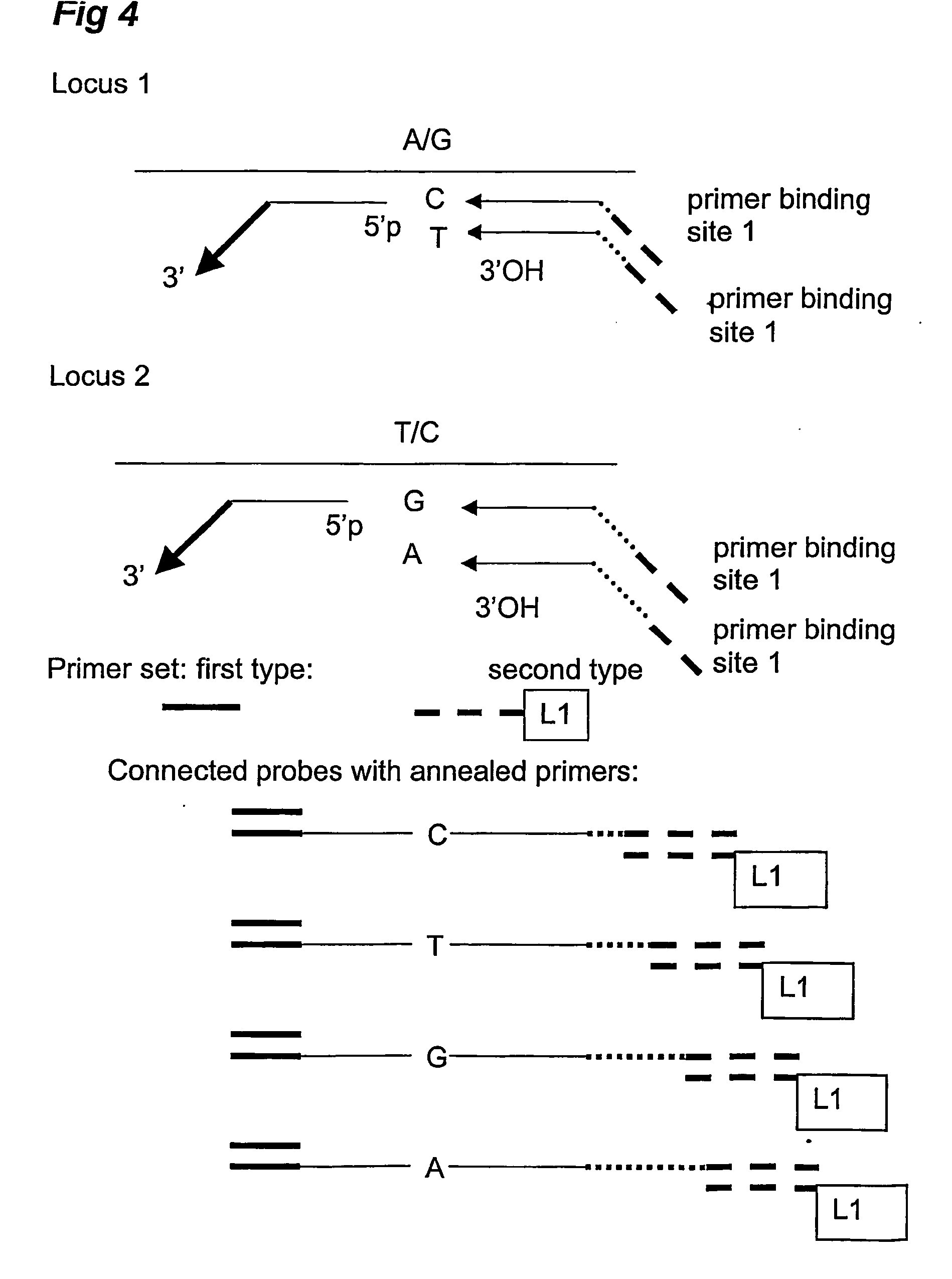Analysis and detection of multiple target sequences using circular probes
a technology of multiple target sequences and probes, applied in the field of biotechnology, can solve the problems of difficult automation of array-based detection, high cost per datapoint, and inability to achieve the effect of reducing the cost of analysis, and avoiding the use of a large number of samples
- Summary
- Abstract
- Description
- Claims
- Application Information
AI Technical Summary
Benefits of technology
Problems solved by technology
Method used
Image
Examples
example 1
Description of Biological Materials and DNA Isolation
[0198] Recombinant Inbred (RI) lines generated from a cross between the Arabidopsis ecotypes Colombia and Landsberg erecta (Lister and Dean, Plant Journal, 4, pp 745-750, (1993) were used. Seeds from the parental and RI lines were obtained from the Nottingham Arabidopsis Stock Centre.
[0199] DNA was isolated from leaf material of individual seedlings using methods known per se, for instance essentially as described in EP-0534858, and stored in 1×TE (10 mM Tris-HCl pH 8.0 containing 1 mM EDTA) solution. Concentrations were determined by UV measurements in a spectrophotometer (MERK) using standard procedures, and adjusted to 100 ng / μl using 1×TE.
example 2
Selection of Arabidopsis SNP's
[0200] The Arabidopsis SNP's that were selected from The Arabidopsis Information Resource (TAIR) website: http: / / www.arabidopsis.org / SNPs.html:, are summarised in Table 6 in
TABLE 6Selected SNPs from Arabidopsis thaliana.SNPSNP alleles*RI Map position1SGCSNP1G / Achr. 2; 72, 812SGCSNP20A / Cchr. 4; 15, 693SGCSNP27T / Gchr. 3; 74, 814SGCSNP37C / Gchr 2; 72, 455SGCSNP39T / Cchr. 5; 39, 646SGCSNP44A / Tnot mapped7SGCSNP55C / Achr. 5; 27, 688SGCSNP69G / Achr. 1; 81, 849SGCSNP119A / Tchr. 4; 62, 0610SGCSNP164T / Cchr. 5; 83, 7311SGCSNP209C / Gchr. 1; 70, 3112SGCSNP312G / Tchr. 4; 55, 95
*For all SNP's the allele preceding the backslash is the Colombia allele.
example 3
Oligonucleotide Probe Design for Oligonucleotide Ligation Reaction
[0201] The oligonucleotide probes (5′-3′ orientation) were selected to discriminate the SNP alleles for each of the twelve SNP loci described in Example 2. PCR binding regions are underlined, stuffer sequences are double underlined. Reverse primers are phosphorylated at the 5′ end:. p indicates phosphorylated. The sequences are summarised in Table 7.
TABLE 7Oligonucleotide probes for detection ofColombia and Landsberg SNPsSEQ.IDCodeNucleotide sequenceSCGSNP11SNPfwd001 (G allele)CGCCAGGGTTTTCCCAGTCACGACTTCAGGACTAGTCTATACCTTGAG2SNPfwd002 (A allele)CGCCAGGGTTTTCCCAGTCACGACGACTTCAGGACTAGTCTATACCTTGAA3SNPrev001 (CommonpCTATGTGAACCAAATTAAAGTTTACTCCTGTGTGAAATTGTTATCCGreverse SNP001)CTSGCSNP204SNPfWd003 (A-allele)CGCCAGGGTTTTCCCAGTCACGACCTGCTCTTTCCTCGCTAGCTTCAGA5SNPfWd004 (C-allele)CGCCAGGGTTTTCCCAGTCACGACGACTGCTCTTTCCTCGCTAGCTTCAGC6SNPrev002 (commonpAGATTCGGACCTTCTCTCATAATCCGACTTCCTGTGTGAAATTGTTATreverse SNP20):CCGCTSGCSNP...
PUM
| Property | Measurement | Unit |
|---|---|---|
| ionic strength | aaaaa | aaaaa |
| melting temperature | aaaaa | aaaaa |
| melting temperature | aaaaa | aaaaa |
Abstract
Description
Claims
Application Information
 Login to View More
Login to View More - R&D
- Intellectual Property
- Life Sciences
- Materials
- Tech Scout
- Unparalleled Data Quality
- Higher Quality Content
- 60% Fewer Hallucinations
Browse by: Latest US Patents, China's latest patents, Technical Efficacy Thesaurus, Application Domain, Technology Topic, Popular Technical Reports.
© 2025 PatSnap. All rights reserved.Legal|Privacy policy|Modern Slavery Act Transparency Statement|Sitemap|About US| Contact US: help@patsnap.com



